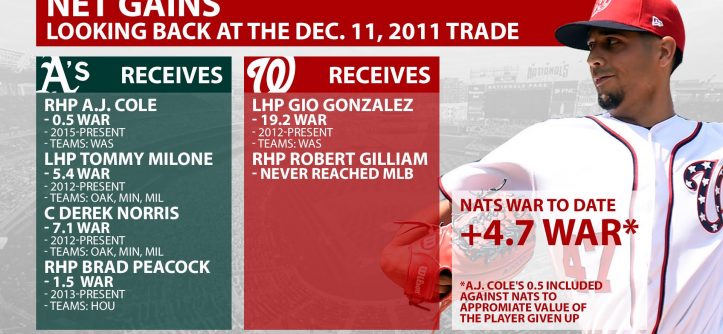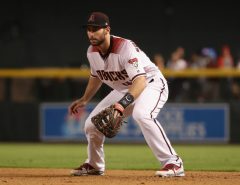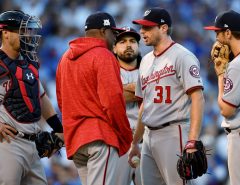Gio Gonzalez‘s great start to this season and the impending trade deadline inspired me to take a look back at the top Nats trades to see how they added up. Mark Zuckerman complied a great list this winter, so I decided to break down the ten trades he wrote about to see how they compared in total WAR for the players involved.
Most of the trades in question include active players, and thus, the conclusion is still in the air. But it’s interesting to see which trades have been winners and losers to this point. Below is each trade and the comparison of total WAR for each player in Mark’s list (as of June 18):
10. 3 Aug 2012: David Freitas to the Oakland Athletics for Kurt Suzuki and cash
Suzuki: 0.8 WAR 2012-2013 (traded to Twins during 2013 season)
Freitas: never made majors, currently in minors with Braves
Nats: +0.8 WAR
9. 13 Feb 2014: Nathan Karns to the Tampa Bay Rays for Jose Lobaton, Felipe Rivero, and Drew Vettleson
Lobaton: 0.3 WAR 2014-present
Rivero: 1.6 WAR 2015-2016 with Nats (traded for Mark Melancon)
Vettleson: never reached higher than AA for Nats, currently in minors with Rangers
Karns: 3.0 WAR 2014-present (for Rays, Mariners, and Royals, 1.4 WAR with Rays)
Nats: -1.1 WAR
8. 30 July 2016: Felipe Rivero and Taylor Hearn to the Pittsburgh Pirates for Mark Melancon
Melancon: 0.9 WAR 2016 for Nationals
Rivero: 1.2 WAR since 2016 for Pirates
Hearn: In high A with Pirates after being promoted from low A
Nats: -0.3 WAR to date
7. 29 Nov 2012: Alex Meyer to the Minnesota Twins for Denard Span
Span: 8.8 WAR 2013-2015 for Nats
Meyer: 0.8 WAR 2015-present for Angels (0.0 WAR for Twins)
Nats: +8.0 WAR to date
6. 28 June 2009: Ryan Langerhans to the Seattle Mariners for Michael Morse
Morse: 4.2 WAR 2009-2012 for Nats
Langerhans: 0.8 WAR 2009-2011 for Mariners
Nats: +3.4 WAR
5. 22 Dec 2011: A.J. Cole, Tommy Milone, Derek Norris, and Brad Peacock to the Oakland Athletics for Gio Gonzalez and Robert Gilliam
Gonzalez: 19.2 WAR 2012-present
Gilliam: never progressed higher than AA, out of MLB
Cole: 0.5 WAR 2015-present (all since returning to Nats, never made majors with A’s)
Milone: 5.4 WAR 2012-present (for A’s, Twins, and Brewers)
Norris: 7.1 WAR 2012-present (for A’s, Padres, and Rays)
Peacock: 1.5 WAR 2013-present (for Astros, 1.4 WAR this season alone)
Nats: +4.7 WAR* (*Cole’s 0.5 included against Nats to approximate value of the player given up)
4. 2 Dec 2013: Steve Lombardozzi, Ian Krol, and Robbie Ray to the Detroit Tigers for Doug Fister
Fister: 1.6 WAR 2014-2015
Ray: 7.1 WAR 2014-present (-0.1 WAR for Tigers 2014)
Krol: -0.1 WAR 2014-present (-0.9 WAR for Tigers 2014-15)
Lombardozzi: -0.8 WAR 2014-2017 (for Orioles, Pirates, Marlins–never played for Tigers, currently in minors)
Nats: -4.6 WAR to date
3. 19 Dec 2014: Steven Souza Jr. and Travis Ott to the Tampa Bay Rays for Joe Ross and Trea Turner from the San Diego Padres
Turner: 4.3 WAR 2015-present
Ross: 3.8 WAR 2015-present
Souza Jr.: 5.0 WAR 2015-present
Nats: +3.1 to date
2. 29 July 2010: Matt Capps and cash to the Minnesota Twins for Wilson Ramos and Joe Testa
Ramos: 10.2 WAR 2010-16
Capps: 0.6 WAR 2010
Testa: 24 AA innings
Nats: +9.6 WAR
1. 30 July 2010: Cristian Guzman to the Texas Rangers for Tanner Roark and Ryan Tatusko
Roark: 8.6 WAR 2013-present
Tatusko: never made majors
Guzman: -0.7 WAR 2010
Nats: +9.3 to date
Looks like Mark did pretty well, with a couple very notable exceptions. He listed the Roark trade as the best of the Mike Rizzo era and, most likely, it will be by the end of the year, despite Roark’s up-and-down season. Plus, Roark still has two more years of team control to run up his lead.
The Wilson Ramos and Denard Span trades were also big winners, wherein the Nats gave up very little and got a lot. The best player given up by the Nats is Robby Ray. Since joining the Arizona Diamondbacks and after doing nothing for the Tigers, he’s turned himself into a premier starting pitcher and one of the best strikeout guys in the league.
The Fister trade is a classic example that you can’t judge trades too quickly. It was widely seen as a lopsided deal for the Nats at the time, and for the first few years it was. The Tigers were ultimately right about Ray, but unfortunately for them, they traded him before his potential was realized. Fister served his purpose and it’s taken Ray years to turn the corner so it’s hard to judge that trade too harshly.
Then comes Gonzalez. He has been, far and away, the most valuable player acquired by the Nats. Unlike the other top deals, multiple players were given up to get him. All four guys that Rizzo sent to Oakland were relatively highly thought of at the time. For Gio to surpass all of them in value this many years later is remarkable. He’ll likely end this season with over 20 WAR as a Nat. He’ll also be a part of the Nats next year if he hits 180 innings to vest the final option year of his contract, which he signed immediately after his acquisition. With over 94 innings pitched in 17 starts, he’s already over half way to 180 IP and has the majority of the season ahead of him. He’s having his best year from a win/loss standpoint since 2012, a 20-win, 5-WAR season.
His overall numbers look similar to years past. The biggest stat, as has been pointed out on this website here and there, is that he’s stranding runners on base at an abnormally high level. His current LOB% is 84.5% vs. his career average of 73.4%, which also happens to be the league average. His walks per 9 innings are down but so are his strikeouts. His fastball velocity is also down slightly from last year and significantly from his best years (90.2 mph this year, from 90.8 last year and 93.1 in 2012). So the fear is that he’s just been lucky, since Left on Base % is seen a luck stat.
While I expect Gio’s LOB% to fall, it’s worth noting that he is doing something different to produce that number: He’s increasing his strikeouts as guys get on base for the first time in his career. Over his career, Gio’s strikeout rate falls as guys get on base. In low, medium, and high leverage situations his K/9 rate is 9.65/8.12/8.00 respectively. Last year it was 10.37/7.37/8.41. However this year, Gio is bearing down more and improving his K/9 rate as he gets in more trouble – to the tune of 8.21/7.57/13.50(!). By getting more strikeouts in the high leverage situations, he’s getting out of jambs that used to get the better of him.
We’re now in the 6th season since the trade, and Gio is still a highly productive pitcher who is finding new ways to get the job done. He’s been everything the Nats had hoped for: A workhorse lefty starter who gives his team a chance every fifth day, which is why his option was picked up for this year and why it’d be a great thing for the Nats if next year’s option vests.
As the Nats enter this year’s trade market, they’ll be hard pressed to make a better deal than they did for Gio. Of course, we’d all like every trade to be more like the Ramos, Span, and Roark deals in which the team gets a valuable starter for virtually nothing. Deals like that don’t come around very often so it’s amazing that Rizzo landed three. More realistic deals are ones like the Gio and Adam Eaton trades in which both teams make tough decisions, and you hope that the guy you get works out.
Rizzo has proven he knows what he’s doing. After looking into his greatest hits, it’s evident he’s earned his hashtag #InRizzoWeTrust.
Tags: Gio Gonzales, Mike Rizzo, Nationals, Nats, Washington Nationals




Leave a Reply